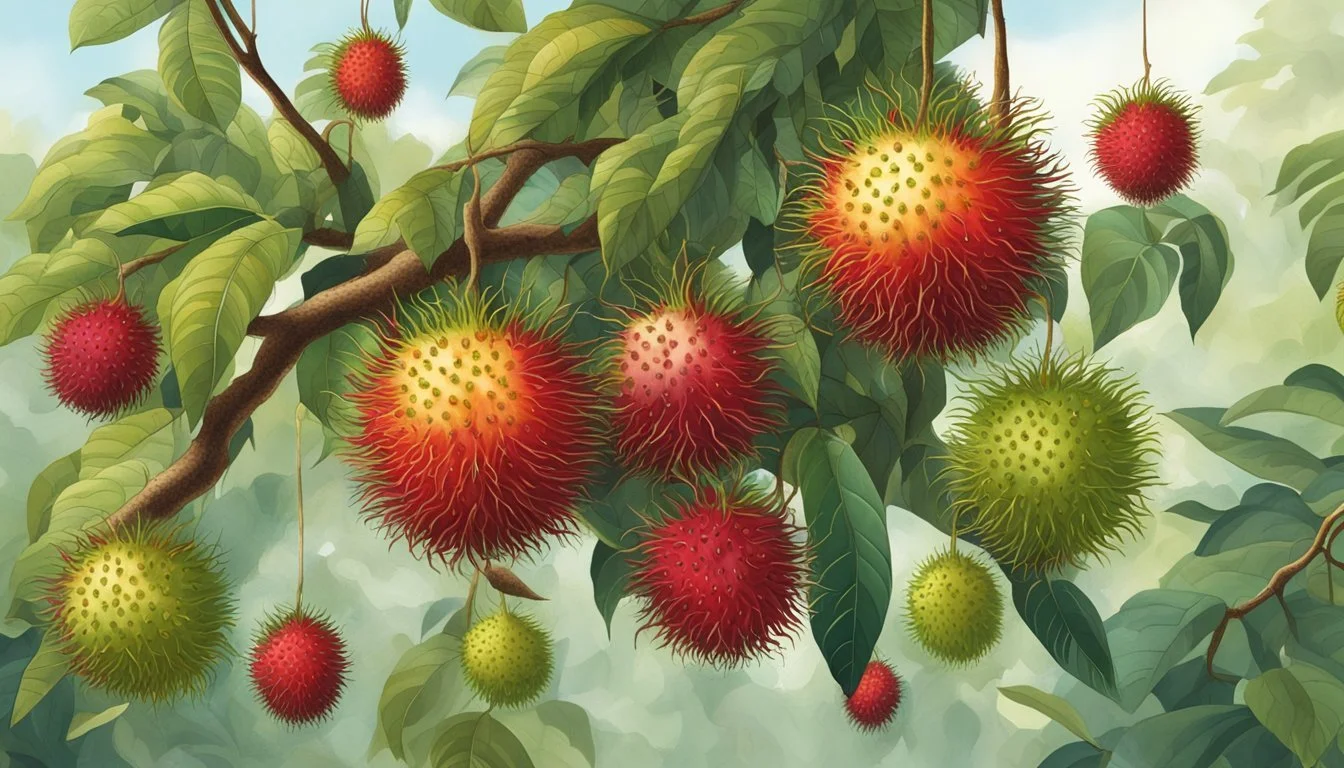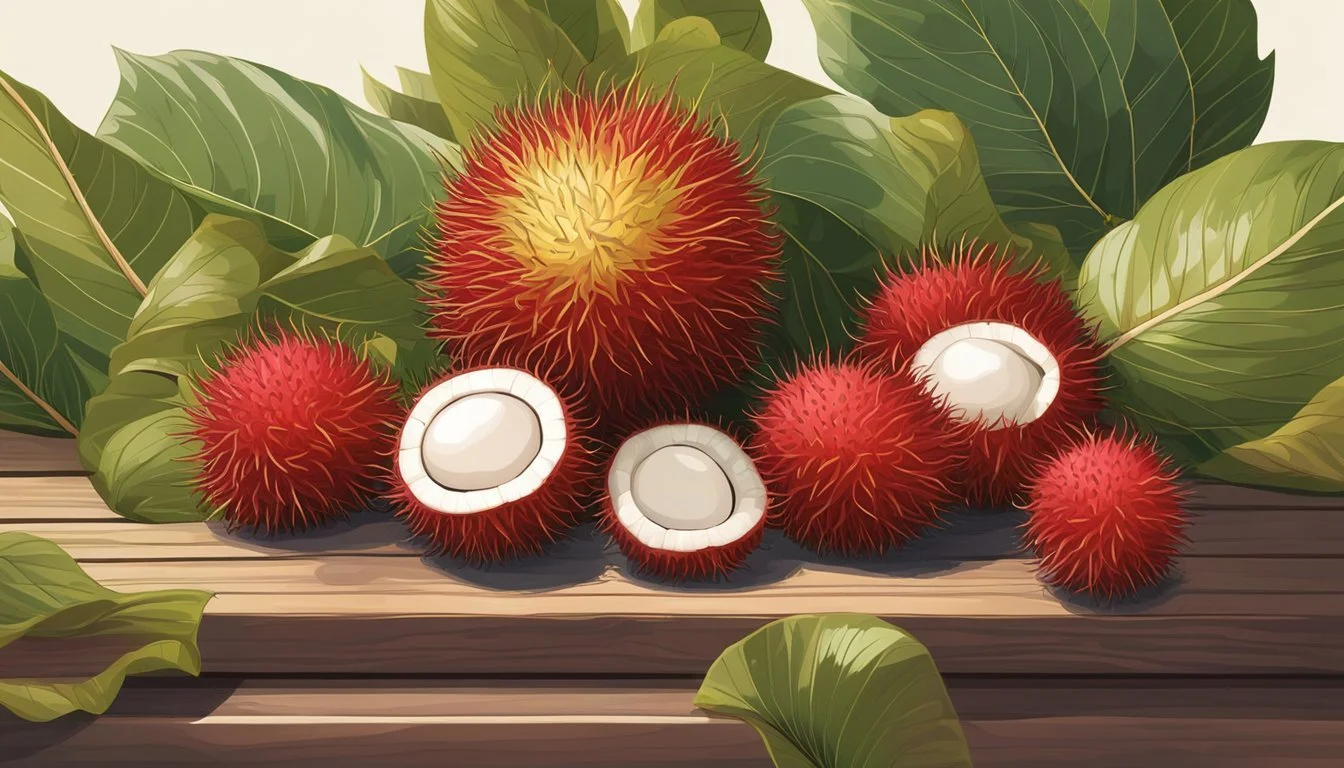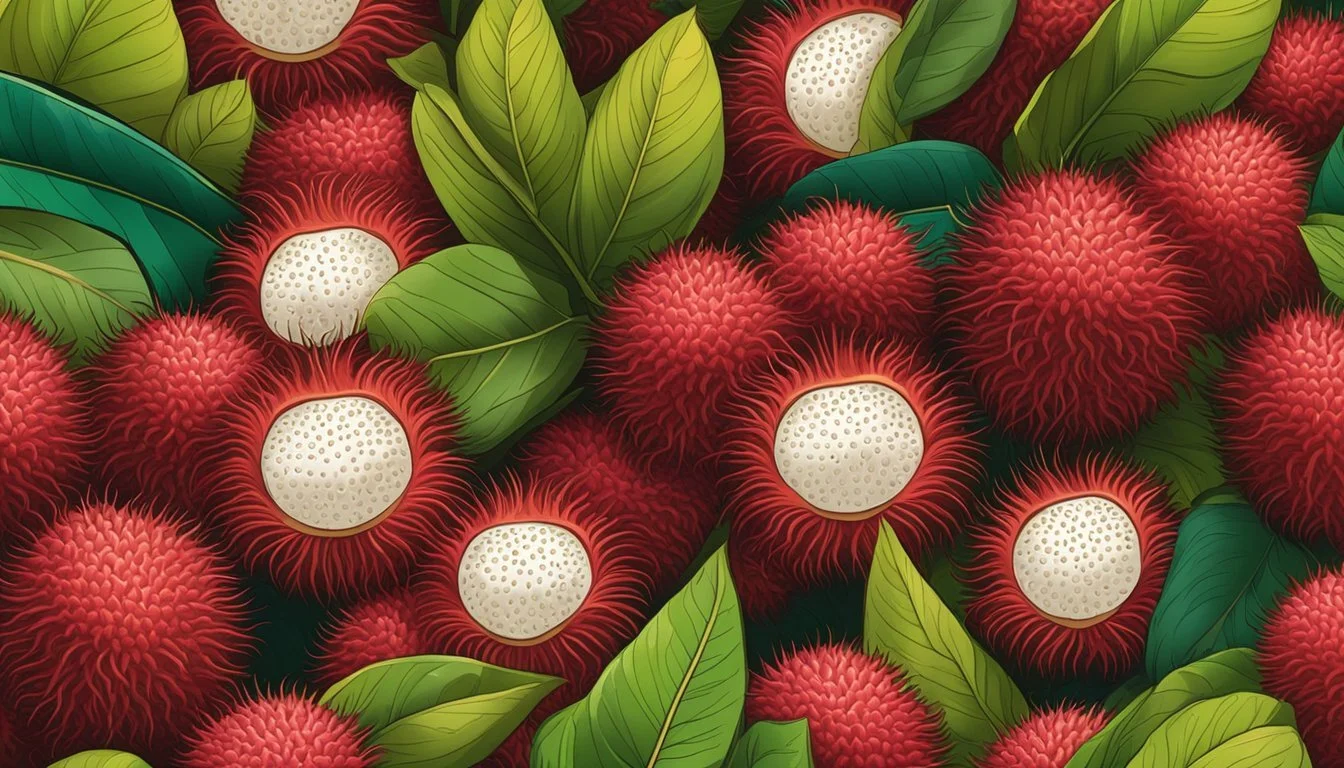How to Tell if a Rambutan is Ripe
Expert Advice for Selecting the Sweetest Fruit
Rambutan, a vibrant tropical fruit native to Southeast Asia, has captured the interest of fruit lovers with its unique appearance and sweet, juicy flavor. Discerning the right time to enjoy this fruit ensures that individuals get the best taste experience from rambutans. Like many tropical fruits (What wine goes well with fruits?) , the rambutan's ripeness can significantly impact its flavor and texture. A ripe rambutan delights the senses with its optimal sweetness and suitably tender flesh, making the knowledge of identifying its ripeness invaluable to enthusiasts and first-time tasters alike.
Understanding when a rambutan is ripe involves observing specific visual and tactile cues. The color of the fruit is a prime indicator; a ripe rambutan typically boasts a bright red or yellow skin, although this may vary slightly depending on the variety. The spiky outer layer should give way to gentle pressure, indicating softness without being mushy – a sign of overripeness. With these signs in mind, consumers can confidently select rambutans that are ready to be enjoyed, either eaten fresh or incorporated into various culinary delights.
Key Takeaways
Recognizing a ripe rambutan involves looking for a bright skin color and a firm yet yielding texture.
Rambutan, a native fruit of Southeast Asia, should be consumed when ripe to experience its full sweetness and satisfactory texture.
Once ripe, rambutans should be stored properly and consumed swiftly to maintain their ideal taste and nutritional benefits.
Identifying Ripe Rambutan
To ensure one enjoys the full sweetness and succulent flavor of rambutan, it's essential to recognize the signs of ripeness before consumption.
Color Changes
A ripe rambutan typically exhibits a bright red or yellow skin color, depending on the specific variety. The color change is a reliable indicator, as immature fruits will have a more muted green or pale hue. They generally do not ripen further once picked, so choosing fruit with vividly colored skin is key.
Texture and Firmness
The spikes or hairs on the surface of a ripe rambutan should appear plump and firm, signaling not only maturity but also freshness. The skin should be relatively smooth and devoid of major imperfections. Overripe or spoiling rambutans may have soft spots or discolorations such as brown or black areas, indicating that the fruit is past its prime for eating.
Aroma and Flavor
A ripe rambutan releases a subtle sweet aroma that can entice the senses. When eating, one should expect a sweet flavor, indicative of ripeness. Unripe rambutans may lack this fragrance and have a more sour or bland taste, while overripe fruits may have an off-putting odor and an overly fermented flavor profile.
Understanding Rambutan and Its Origins
The rambutan, scientifically named Nephelium lappaceum, is a tropical fruit treasured for its unique appearance and sweet flavor. Originating from Southeast Asia, it is now grown in warm climates worldwide, including the Philippines.
The Rambutan Tree
The rambutan tree belongs to the Sapindaceae or soapberry family, which also includes other exotic fruits like lychee and longan. These trees thrive in tropical climates where temperatures and humidity remain high throughout the year. Rambutan trees are medium-sized, reaching heights of up to 20 meters. They bear fruit twice annually, producing round to oval fruits covered with hair-like protrusions.
Rambutan vs. Related Fruits
Rambutan is often compared to its relatives, lychee and longan, due to similarities in taste and texture. However, there are distinct differences:
Rambutan: Covered in soft, flexible spines, the rambutan's skin turns from green to red or yellow when ripe. Its flesh is juicy, sweet, and slightly acidic.
Lychee: The lychee has a rough, leathery red skin that peels away easily to reveal a white, translucent fruit. It is sweet with a floral aroma.
Longan: This fruit has a smooth, tan-colored shell, with a more subdued sweetness than lychee or rambutan and less acidity.
While similar in their tropical origin and membership in the soapberry family, each of these fruits has a unique profile that distinguishes it within the Sapindaceae family.
Health Benefits and Nutritional Value
Rambutan, a tropical fruit, is celebrated for its impressive nutritional profile that includes a bounty of vitamins, minerals, and other beneficial compounds. Consuming rambutan can contribute significantly toward daily nutritional requirements, especially in terms of vitamin C and essential trace minerals.
Vitamins and Minerals
Vitamin C: A serving of 5-6 rambutan fruits provides about 50% of the daily Vitamin C needs, essential for iron absorption and immune function.
Copper: Vital for growth and maintenance, rambutan is a rich source of copper.
Manganese: This mineral is also found in rambutan and is important for bone health and metabolism.
Potassium: Important for heart health, rambutan contains this key electrolyte.
Folate: Essential for DNA synthesis and repair, folate is another nutrient found in this fruit.
The fruit's contribution to daily mineral intake supports a range of bodily functions, from collagen production to immune system efficacy.
Dietary Considerations
Fiber: Fiber in rambutan aids in digestive health and can help maintain healthy blood sugar levels.
Low Fat: Rambutan is naturally low in fat, making it a healthful addition to various diets.
Antioxidants: The vitamin C in rambutan acts as a potent antioxidant, helping to combat free radicals in the body.
Caloric Content: Rambutan has a relatively low-calorie count, providing a satisfying and nutrient-rich snack option.
Rambutan's nutritional value coupled with its dietary fiber underscores its potential benefits for heart health and its role in maintaining a robust immune system.
Storing and Preserving Rambutan
To maintain the freshness and flavor of rambutan, precise storage methods are essential. Understanding the ripening process and the appropriate long-term storage techniques will ensure rambutans retain their quality.
Ripening After Harvesting
Once harvested, rambutan may continue to ripen, albeit slowly. While the fruit does not produce ethylene—a ripening agent—the process can still proceed at room temperature. Rambutan is ideally kept at temperatures between 45°F (7°C) and 50°F (10°C) to slow ripening and extend shelf life. If one has unripe rambutan, leaving them out in a cool, dry area away from direct sunlight can facilitate natural ripening.
Long-Term Storage Techniques
For long-term preservation, it's pivotal to control both temperature and humidity. Storing rambutan involves refrigeration to combat spoilage and dehydration. They should be placed in a breathable container or a perforated plastic bag to allow air circulation. To optimize storage conditions in the refrigerator, aim for a humidity level between 85-90% to prevent drying out. A ripe rambutan can last up to a week under these conditions, while maintaining a cool, dry environment is key to prolonging freshness.
Selecting and Preparing Rambutan
When selecting and preparing rambutans, one should look for signs of juicy flesh and maturity, while also mastering peeling techniques to enjoy this exotic fruit's offerings.
How to Choose at the Store
When at the store, inspecting the rambutan for ripe characteristics is key. Ripe rambutan will exhibit a bright red or yellow color, depending on the variety, with firm spines. The hairy skin should not show signs of wrinkles or blemishes, as these may suggest over-ripeness. A gentle squeeze test can help assess firmness; the fruit should yield slightly under pressure indicating juicy flesh.
Color: Bright red or yellow, variety-dependent
Spines: Firm not limp
Skin: Smooth, free of blemishes and wrinkles
Firmness: Slight give on gentle squeeze
Smell: Fragrant, sweet aroma
Avoid fruits with excessive brown or black spots, which might signal spoilage.
Preparation and Peeling Techniques
To prepare a rambutan for consumption, clean it under running water first. Peeling begins by making an incision in the hairy skin without puncturing the white flesh beneath. Then, one should peel away the skin to reveal the edible interior. It's important to handle the fruit carefully to keep the juicy flesh intact. The membrane may cling to the seed inside; it is usually not eaten.
Clean: Rinse under running water.
Peel: Cut into the skin and peel away to reveal flesh.
Remove: Detach flesh from the seed, and discard the membrane if present.
Enjoy: The fruit is ready to eat once peeled.
Using these techniques, one can easily prepare and savor the perfect fruit with ripe, juicy flesh.
Incorporating Rambutan into Your Diet
Rambutan, a sweet and exotic tropical fruit, makes a versatile addition to various dishes due to its creamy texture and distinctive flavor. The fruit's juicy flesh can enhance both sweet and savory recipes, making it a unique ingredient to experiment with in the kitchen.
Simple Ways to Enjoy Rambutan
One can enjoy rambutan in its natural state, simply by peeling the skin and removing the seed. The fruit's inherent sweetness makes it a refreshing snack on its own. For a quick treat, rambutan can be added to fruit salads for a tropical twist. Given its creamy texture, rambutan pairs well with other tropical fruits like mango and pineapple, enriching the overall flavor profile of the dish.
Snack: Peel and eat fresh rambutan.
Fruit Salad: Combine with mango, pineapple, and a sprinkle of lime juice.
Recipes and Pairings
Rambutan can also be incorporated into an array of recipes. Its juicy flesh complements the zest in cocktails, where it can be muddled or used as a garnish, adding an exotic touch to the beverage. For a cooling dessert, blend rambutan into smoothies or ice creams. These creamy confections will echo the luxurious texture of the fruit itself.
Smoothies: Blend with banana, yogurt, and a touch of honey.
Cocktails: Muddle rambutan with mint and mix into a tropical mojito.
Salads: Toss slices of rambutan into a green salad with a citrus dressing for a sweet contrast.
Desserts: Puree rambutan and fold into jelly or incorporate into homemade ice cream.
In savory applications, the fruit's sweetness complements spicy dishes and can be added to salads with a spicy dressing or combined with citrus to create a salsa for grilled fish or chicken. Cooking enthusiasts can further explore rambutan's potential by creating unique glazes for meats or as a surprising element in stir-fry dishes.
Rambutan Varieties and Characteristics
When selecting rambutan, it's important to recognize the diverse varieties and understand their distinct characteristics. This knowledge is instrumental in ensuring consumers enjoy the optimal flavor and texture that this tropical fruit has to offer.
Common Varieties
Rongrien: This variety is known for its sweet flavor and bright red skin, which signals ripeness and ready-to-eat fruit.
Si Chompu: With a unique pinkish-red color, Si Chompu also possesses a sweet taste, complemented by floral notes, setting it apart from others.
Binjai: The Binjai variety tends to be slightly tart with a crunchier texture, identified by its sometimes less vibrant coloration.
Unique Traits of Different Varieties
Each rambutan variety presents unique traits that help in determining their ripeness and quality. Color changes in the spiky fruit's skin are key indicators. For instance, a transition from green to deep red, orange, or yellow hues usually signifies that the rambutan is ripe and ready to consume. Furthermore, a creamy texture often accompanies the mature fruit, enhancing the overall sensory experience.
The Science of Rambutan Maturation
Understanding the maturation of rambutans, tropical fruits from Southeast Asia, involves consideration of climatic factors and plant hormones. The ripening process reflects changes in color and texture that can be influenced by environmental conditions and chemical signals within the fruit.
Climatic Impact on Ripening
Temperature and humidity play crucial roles in the ripening of rambutans. These tropical fruits thrive and mature best under specific climatic conditions akin to their native tropical climate.
Temperature: A warmer environment typically speeds up the ripening process. Conversely, cooler temperatures are known to retard the ripening, extending the time it takes for rambutans to reach full maturity.
Humidity: Ripe rambutan often exhibit better quality under high humidity conditions, which mimic their natural tropical habitat. Lower humidity can slow down the ripening process, thus impacting the overall quality of the fruit.
Ethylene and Fruit Maturation
Ethylene is a natural plant hormone that significantly affects the maturation of many fruits, including rambutans. Although rambutans are classified as non-climacteric fruits, meaning they do not continue to ripen after being harvested, ethylene exposure still has an influence during the pre-harvest phase.
Production: Rambutans produce less ethylene than climacteric fruits, and their response to this hormone is less pronounced in the post-harvest period.
Ripening Process: Ethylene regulates the ripening process before harvest, leading to color change from green to red or yellow, depending on the variety. The presence of ethylene can also contribute to the softening of the rind and the development of the sweet flavor characteristic of a ripe rambutan.
The understanding of these factors can aid distributors and consumers in identifying when a rambutan is ready to be enjoyed at its best.
Rambutan and Food Safety
When selecting rambutans, one should be cautious to avoid overripe or spoiled fruit, which can compromise food safety. Additionally, an understanding of any potential toxins commonly associated with the fruit is crucial for safe consumption.
Avoiding Overripe and Spoiled Fruit
Overripe rambutan may have an undesirable texture and can harbor microbial growth, which poses food safety risks. Consumers should inspect the rambutan for signs that it is past its prime. Key indicators of overripe or spoiling fruit include:
Color changes: Look for dark spots or a dull appearance.
Texture: A soft, mushy consistency can indicate spoilage.
Spike condition: The once firm spikes may become brittle or dry.
For optimal storage and to avoid overripening, rambutans should be kept in a cool, dry place. If refrigerated, they can last longer, but one should not keep them beyond two weeks as the quality can deteriorate. Any bruised or damaged rambutans should be consumed quickly or discarded to prevent the spread of spoilage.
Understanding Potential Toxins
Rambutans are generally safe to eat, but like many fruits, certain parts can contain toxic substances. The central seed of a rambutan is not edible. The seed contains saponin, which, while not lethal, can cause adverse effects if ingested in large quantities. The seed should always be removed and not consumed.
When handling rambutans, one should ensure they are thoroughly washed to remove any potential residual pesticides or contaminants from their surface. It's worth noting that proper handling and preparation significantly reduce any risk of ingesting toxic substances.
Frequently Asked Questions
How can one identify a ripe rambutan?
To determine the ripeness of a rambutan, one should look at its skin. A ripe rambutan typically exhibits a bright red or yellow color, depending on the variety. The spikes, or hairs, should feel plump and firm. The skin must be smooth and free from blemishes or brown spots, which could indicate over-ripeness or spoilage.
What is the correct texture of a ripe rambutan?
The fruit should yield slightly to pressure but not be too soft. An unripe rambutan is generally firmer and may exhibit a greenish hue, while an overripe one may feel mushy.
What about the taste and seed of a ripe rambutan?
Ripe rambutans have a juicy and sweet taste, with a slight floral note. The seed inside should be brown and firm. One should avoid eating the seed as it can be bitter.
When is the rambutan harvest season?
The harvest season for rambutan varies by region but generally falls between late spring and late fall.
How does one store rambutan to maintain its freshness?
Rambutans should be stored in a cool, dry place and can be kept in the refrigerator for up to 3 days once ripe. They can also be kept at room temperature while they ripen over a couple of days.
What are the health benefits and nutritional value of rambutan?
Rambutans are rich in vitamin C, beneficial for one's immune system, and are also a good source of fiber. They offer minor amounts of iron and calcium and are low in calories.
Can rambutans be eaten raw?
Yes, rambutans are typically consumed raw. One should simply peel the skin and enjoy the flesh, but not the seed.





